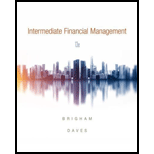
a)
To determine: Whether the changes in credit terms can be made.
a)
Explanation of Solution
Cash discounts:
- Cash discounts are generally given to boost the early payments
- To attract the customers by way of lowering the prices effectively.
- Some credit terms are 2/10, net 30 this denotes that a 2% discount will apply when the payment is made within the 10 days or else the account will be paid within 30 days
b)
To determine: Seasonal dating
b)
Explanation of Solution
Seasonal dating arranges the invoice date or the date at which the discount and credit period starts, to a time during the own selling season of the buyers irrespective of the actual sale date.
c)
To determine: Aging schedule and DSO-days sales outstanding.
c)
Explanation of Solution
An aging schedule divide the accounts receivable according to the time period that is how long the receivables been outstanding.
It provides a clear picture on the accounts receivables structure than which is provided by DSO. Whereas,
DSO is the measure of average length of time which is taken for customers to make payments on their credit purchases.
d)
To determine: Uncollected balances schedule.
d)
Explanation of Solution
It shows the remaining uncollected receivables of each month as a % of month’s sales. By comparing this over time can be find the changes in the payment behavior of the customers, can avoid the misleading signals which are given by aging schedule and DSO when sales are seasonal.
e)
To determine: Discount interest, simple interest and add on interest.
e)
Explanation of Solution
- The case when the interest is not earned on interest is termed as simple interest
- Discount interest is determined on the face value of the loan but it is paid in advance.
- Add-on interest is termed as an interest and it is determined and added to the funds which are received to evaluate the face value of an installment loan.
Want to see more full solutions like this?
Chapter 22 Solutions
Intermediate Financial Management (MindTap Course List)
- What is the future value of $500 invested for 3 years at an annual compound interest rate of 4%?arrow_forwardA loan of $10,000 is taken at an annual interest rate of 6% for 5 years. What is the total interest payable under simple interest? Expalarrow_forwardA loan of $10,000 is taken at an annual interest rate of 6% for 5 years. What is the total interest payable under simple interest?arrow_forward
- You borrow $8,000 at an annual interest rate of 7%, and it compounds yearly for 2 years. What is the total amount payable? Helparrow_forwardYou borrow $8,000 at an annual interest rate of 7%, and it compounds yearly for 2 years. What is the total amount payable?arrow_forwardIf a bond pays $50 annually and is priced at $1,000, what is its annual yield? Explarrow_forward
- If a bond pays $50 annually and is priced at $1,000, what is its annual yield?arrow_forwardA car loan of $15,000 is taken for 3 years at an annual interest rate of 8%. What is the simple interest payable?arrow_forwardYou gave me unhelpful so i am also gave you unhelpful.if you will not give unhelpful then also i will not give unhelpful. what is finance?arrow_forward
- You want to save $15,000 in 5 years. If your bank offers 3% annual interest, how much should you invest today? (Use compound interest.) Explarrow_forwardIf you invest $2,000 at an annual interest rate of 6%, compounded annually, for 3 years, what is the future value?arrow_forwardYou want to save $15,000 in 5 years. If your bank offers 3% annual interest, how much should you invest today? (Use compound interest.)arrow_forward
 Intermediate Financial Management (MindTap Course...FinanceISBN:9781337395083Author:Eugene F. Brigham, Phillip R. DavesPublisher:Cengage Learning
Intermediate Financial Management (MindTap Course...FinanceISBN:9781337395083Author:Eugene F. Brigham, Phillip R. DavesPublisher:Cengage Learning College Accounting (Book Only): A Career ApproachAccountingISBN:9781337280570Author:Scott, Cathy J.Publisher:South-Western College Pub
College Accounting (Book Only): A Career ApproachAccountingISBN:9781337280570Author:Scott, Cathy J.Publisher:South-Western College Pub- Principles of Accounting Volume 1AccountingISBN:9781947172685Author:OpenStaxPublisher:OpenStax College



